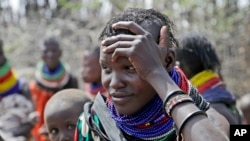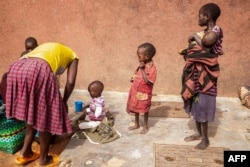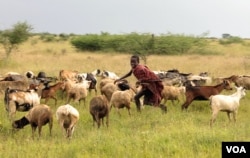According to the United Nations World Food Program and human rights groups, a record 150 million people will go hungry in Uganda and other parts of Africa this year.
Images of people starving to death in Africa have been broadcast around the world for decades, with the estimates increasing from more than 1.3 million victims in the 1980s to 2.8 million in the 2000s.
Past famines were caused by drought, conflicts and high food prices.
Last year, 2,200 people died of hunger and starvation in northeastern Uganda, according to the Ugandan Human Rights Commission.
On January 25, Uganda’s Foreign Affairs Minister Henry Okello Oryem played down the threat of famine, calling those dying of hunger in his country “idiots”:
"The people dying of hunger in Uganda are idiots because there is enough food, land and the climate is right in spite [of] climate change. If you work hard, if you make a double effort to make sure that you go out in the morning, you till your land, you plant the seeds, you maintain your plantation, surely, how do you fail then to get food?"
Oryem’s claim is false.
According to the U.N., there are multiple causes of food insecurity in Uganda. These include increasing climate vulnerability, the political situation, gender inequality, rising conflict, increasing food prices, the prevalence of livestock diseases, poverty, landlessness, lack of education, and high fertility rates.
The foreign minister’s assertion is also contradicted by his colleagues.
Last September, Uganda’s Ministry of Agriculture released a report stating that about 8 million Ugandans are suffering from chronic hunger and more could die in 2024.
The ministry’s National Agricultural Research Organization said in statement: “Climate change’s effects are sabotaging efforts to fight hunger and poverty in some parts of the country.”
The United Nations Food and Agriculture Organization said Uganda is vulnerable to climate-related challenges and warned of potential economic losses amounting to about $26 million by 2050:
“Given the dependence of Uganda’s economy on agriculture and natural resources, the country is particularly vulnerable to climate change and climate variability, which includes droughts, floods and landslides.”
Foreign Affairs Minister Oryem’s comments appear to have been inspired by Uganda’s president, Yoweri Museveni.
On January 19, Museveni addressed a summit of the Non-Aligned Movement (NAM), held in Uganda’s capital, Kampala, shortly after assuming the movement’s rotating NAM chairmanship, which he will hold for three years. The Kampala NAM summit was attended by 90 representatives, including 30 heads of state, from the 120 NAM member countries.
In his address, Museveni said, among other things: “When you are out there, you may get stereotypes that we do not have food, but we are dying from food here. Those images you see are not representative of all Africa.”
A week later, the 79-year-old Ugandan president celebrated the 38th anniversary of his National Resistance Army/Movement seizing power in the country. Speaking to a group of supporters at the event, Museveni said that while Uganda “is still on the way” to becoming a superpower, “it will soon be there, because the base is already laid."
Yet, despite his optimistic vision of Uganda’s future, stark realities persist in regions like Karamoja, about 487 kilometers north of Kampala.
In this arid region, people are not “dying from food,” as Museveni said, but from the lack of it. Karamoja people, who are herders, die on the roads together with their animals while searching for food.
For the 1 million people who live in the region, climate change is not a matter of speculation. The region is perpetually suffering a drought, and 35% of the children younger than five years old there suffer from stunted growth.
The U.N. Office for the Coordination of Humanitarian Affairs reports that all of Karamoja’s nine districts are experiencing acute food insecurity, with half a million people facing alarming levels of hunger.
According to Uganda’s Bureau of Statistics, 70% of Uganda’s 45 million people are farmers, and only 5 million of its 40 million fertile acres of land have been utilized.
While Uganda is known as Africa’s breadbasket and, according to the World Food Program, it produces more food than it consumes, poverty limits people’s access to nutritious food
But it loses as much as 40% of the crops it harvests to disease, pests, and rot — all caused by poor post-harvest handling and storage. That means hunger, malnutrition and lost income for rural farmers, many of whom were already struggling and exceedingly vulnerable.
The United States is the single largest donor of humanitarian aid to Uganda, investing about $1 billion annually in Ugandan communities
That includes aid dedicated to assisting more than a million refugees hosted by Uganda and funds to fight famine.
The U.S. Agency for International Development said that in northern Uganda “farmers [are] more dependent on the increasingly erratic climate, which has just one annual rainy season from April to October.”
“Concentrated grazing, broad dependence on rain-fed agriculture, and suboptimal farming practices aggravate food needs during the March-to-July lean season—the period of the year when food is most scarce.”








